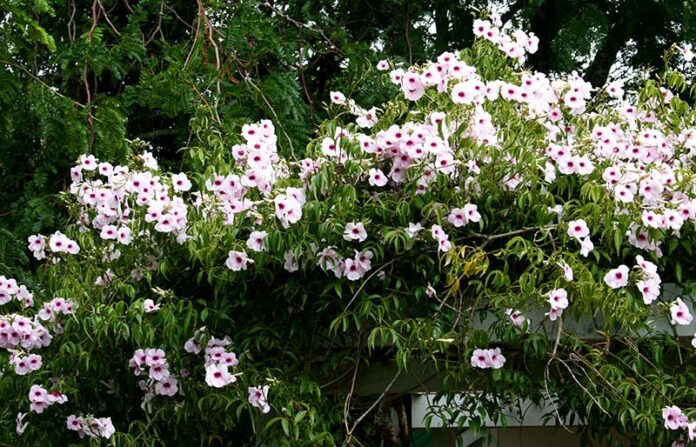
Learn everything from A-Z on how to properly grow your bower vine (Pandorea Vine) in your amazing garden. This detailed guide will make you an expert to grow with success this amazing plant in your beautiful garden.
Bower Vine (Pandorea Vine) is a stunning flowering plant that is popular for its beauty and ease of growth. Whether you’re a seasoned gardener or just starting out, it is a great addition to any garden.
This article will teach you everything you need to know about how to properly grow and care for your Bower Vine, from planting to pruning.
The Pandorea Vine in Brief
Pandorea jasminoides, or the Bower Vine, is a kind of flowering plant in the family Bignoniaceae. It originates in Australia but may be found all over the world in subtropical and tropical climates.
Large, trumpet-shaped blooms in pink, white, and purple are produced by the Bower Vine. It is a frost tender evergreen hardy in USDA zones 9 to 11a climbing plant that may reach a height of 20 feet.
Where to Put That Bower Vine
It is essential to select an appropriate area prior to planting your Bower. The soil should be well-drained and the plant needs full sun to light shade. Because it is so easily harmed by wind, this vine should be avoided in exposed locations.
The Correct Way To Planting Your Pandorea Vine
If you want it to get off to a healthy start and flourish, you’ll need to do some groundwork before you plant it. Instructions for planting Bower Vine are as follows.
Pandorea Vine should be planted in a location that receives full sun or light shade and has well-drained soil. Select a spot that satisfies these needs in your garden. Strong winds can also injure the plant, so it’s best to keep it in a protected location.
Loosen the soil to a depth of at least 12 inches and use compost or other organic matter to get the ground ready for planting. The soil’s fertility and drainage will be enhanced as a result of this. Adding sand or other additions to thick soil might help it drain better.
The hole should be dug to a depth of at least twice the root ball’s diameter. The roots will have room to develop and spread out in this setting. Be sure the hole is deep enough that the top of the root ball will sit flush with the surrounding dirt.
When planting a vine, be sure to carefully remove it from its pot and work to untangle its roots. Fill the hole around the plant with earth. To eliminate air pockets, press the earth down gently.
To help the earth settle around the plant’s roots, give it a good soaking immediately after planting. Particularly in the first several months after planting, make sure to keep the soil wet but not soaked.
Mulching the plant is a great way to keep the soil wet, prevent weeds, and maintain a consistent temperature. Be careful not to bury the stem while applying mulch around the plant’s base.
Like any other climbing plant, will benefit from some kind of support as it develops. Give the vine something to climb, such a trellis, an arbor, or something similar. To train a climbing plant in a certain direction, just connect the stem in a gentle bend to the support structure as it develops.
If you follow these instructions, your plants will have a better chance of getting established and flourishing. If you give the attention it deserves, it will repay you with gorgeous blooms and lush greenery for years to come.
Watering and Fertilizing Bower Vine
It require regular attention, including watering and fertilization. Your vine’s health, flower production, and vitality during the growing season will all benefit from regular watering and fertilizing. The Bower Vine requires regular watering and fertilization; here are some suggestions:
It may grow and bloom beautifully if given adequate water. In the summer, water the plant thoroughly once a week, and less frequently in the winter. Root rot and other plant diseases may be prevented by keeping the soil wet but not saturated.
Also require fertilization to ensure they receive the appropriate nutrients for optimal growth. In the early spring, when the plant is beginning to develop, work a balanced, slow-release fertilizer into the soil around the plant’s base.
A consistent supply of nutrients can be ensured all through the growth season. Bower Vines need to be fed once per month throughout the growth season, either with compost tea or liquid fertilizer.
Maintaining it in good health and appearance requires regular trimming. Remove any dead, damaged, or diseased branches from the plant in late winter or early spring. The plant may be shaped and its size managed by proper pruning. Pandorea Vine is a fast-grower, thus it has to be pruned frequently to keep it from becoming unruly.
The practice of cutting off faded blossoms from a plant is known as deadheading. More blooms will be produced, and the plant will remain nice and tidy. Regular deadheading, or the removal of faded blossoms, will keep it looking its best.
B. Vine in Training
Because of its climbing nature, the it has to be supported. If you want your vine to grow, you’ll need to give it something to climb on, like a trellis. Vine growth may be directed by bending the stem and attaching it to the support structure as the plant matures.
The Successful Bower V. Trimming
This fantastic plant require regular pruning to thrive. Regular pruning will help keep the plant under control and encourage blooming. Before new growth begins in the late winter or early spring, prune the plant. Trim back the plant by removing any overgrown or diseased branches and discarding the rest.
Bower Vine Propagation Methods
The process of propagating Bower Vine is simple and economical. Stem cuttings, layering, and seed are all viable methods of propagating it. Some suggested techniques of propagation are as follows:
Stem cuttings should be taken from a healthy plant and should be around 6 inches in length. Take off most of the leaves, leaving only a few at the top of the stem. Rooting hormone should be applied to the cut end before it is planted in a porous potting soil.
Keep the soil moist by watering it and covering the container with a plastic bag. Set the container in a warm, sunny spot, but keep it out of direct sunlight. Transplant the cutting to a larger container or the garden once it has established roots, which should take a few weeks.
It may be propagated via layering, a technique that allows cuttings to remain connected to the mother plant. Pick a strong stem that can bend easily toward the ground.
Rooting hormone should be applied to the area of the stem that is touching the soil, and then the area should be gently wrapped. Stitch the incision shut with wire or a stone, then cover it with earth.
Allow the roots to grow while you keep the soil moist. It’s time to take the young plant from the mother and move it to a larger container or the garden.
To grow new plants, collect seeds when they have matured and peel off the seed coat. The seeds will have a better chance of germinating if you soak them in warm water for a day.
Sow the seeds in a damp but well-drained potting soil. Set the container in a warm, sunny spot, but keep it out of direct sunlight. Transplant the seedlings to a larger container or the garden after they have several leaves.
Pandorea Vine Common Pests and Diseases
It is a low-care plant that nevertheless needs some TLC because it can get attacked by pests and diseases. It is susceptible to a number of common pests and diseases, the solutions to which are detailed below.
Spider mites
These tiny, reddish-brown bugs are responsible for the yellowing and withering of Pandorea Vine leaves by sucking the plant juices out of them. Keep humidity levels high and water your plant often to discourage spider mites. Insecticidal soap or neem oil can be used to treat a plant if an infestation is discovered.
Scale insects
Bower Vine is plagued by tiny, flat, oval-shaped parasites called scale insects. These insects attach themselves to the plant’s stems and leaves and drink the sap.
Honeydew, a sticky material they emit, can foster the growth of fungi and attract other pests. It may be protected from scale insects by being kept moist and having damaged or dead parts of the plant removed.
Apply insecticidal soap or horticultural oil to your plant if you see signs of an infestation.
Powdery mildew
Powdery mildew is a fungal disease that causes the leaves to become a powdery white or gray. It likes it warm and damp, and it can distort and discolor the leaves.
Avoid getting water on the leaves and instead water it at the base to prevent powdery mildew. Avoid suffocating your plants by not placing too many in one pot. Spray your plant with a fungicide if you see an infestation.
Root rot
It is susceptible to a fungal disease called root rot, which quickly kills off the plant’s roots. Overwatering or poorly draining soil is a common cause of this condition. Make sure your it is in well-drained soil and let the top inch of soil dry out before watering again to avoid root rot.
If the plant begins to wilt, turn yellow, or emit an unpleasant odor, you should dig it up to examine its roots. Root rot is presumably the cause of their brown, mushy appearance. Throw it away and get a new, healthier plant.
Leaf spot
It’s leaves develop circular brown or black patches due to a fungal disease known as leaf spot. Both overwatering and overcrowding can lead to this problem. Make sure the leaves have enough of air and don’t get wet to stop the spread of leaf spot. If you see an outbreak, you should spray your plant with a fungicide and pull off any affected leaves.
Overall, it is low maintenance, but it’s still wise to keep a watch out for common pests and diseases. If you take the time to implement the aforementioned recommendations, you should be able to keep your plant healthy and thriving for many years to come.







![Rose Names And All Rose Types – The Most Detailed Guide [2022] rose names](https://www.yardious.com/wp-content/uploads/2018/05/rose-names-100x70.jpg)










